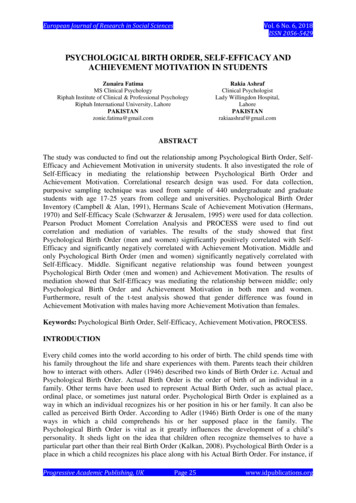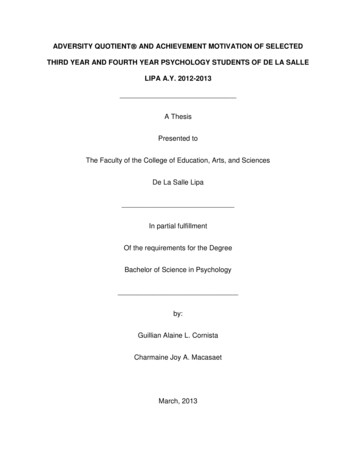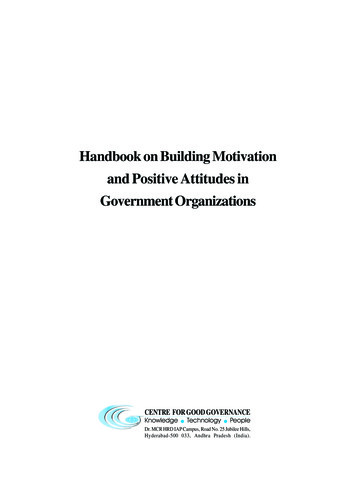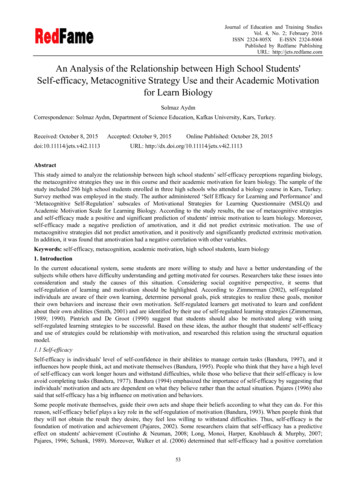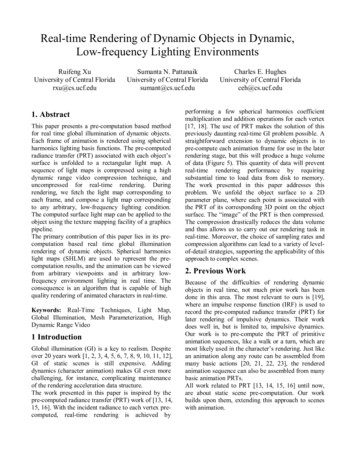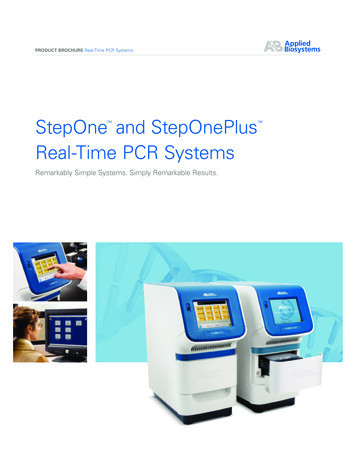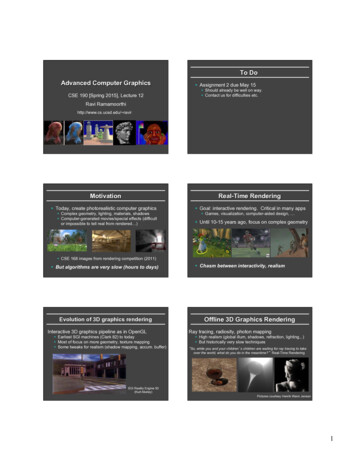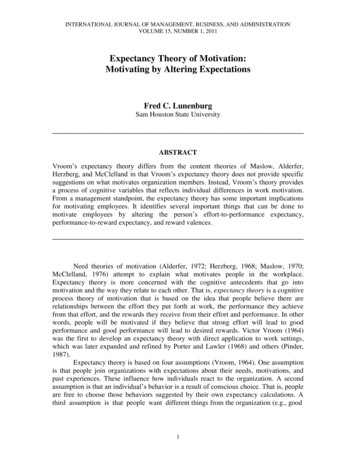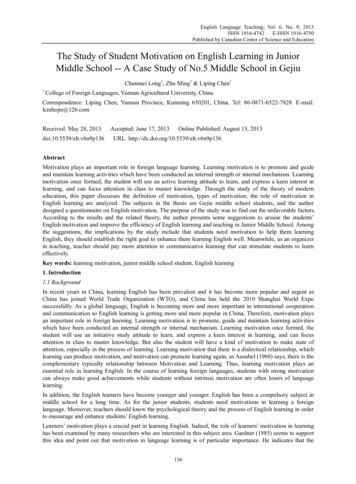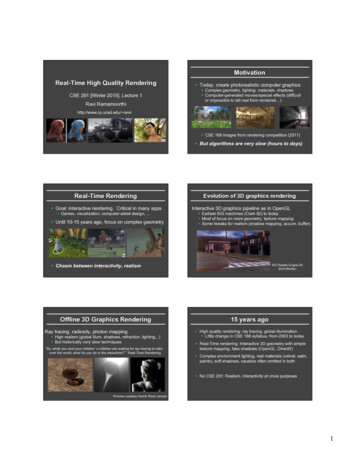
Transcription
MotivationReal-Time High Quality RenderingCSE 291 [Winter 2015], Lecture 1Ravi Ramamoorthi§ Today, create photorealistic computer graphics§ Complex geometry, lighting, materials, shadows§ Computer-generated movies/special effects (difficultor impossible to tell real from rendered )http://www.cs.ucsd.edu/ ravir§ CSE 168 images from rendering competition (2011)§ But algorithms are very slow (hours to days)Real-Time Rendering§ Goal: interactive rendering. Critical in many apps§ Games, visualization, computer-aided design, § Until 10-15 years ago, focus on complex geometryEvolution of 3D graphics renderingInteractive 3D graphics pipeline as in OpenGL§ Earliest SGI machines (Clark 82) to today§ Most of focus on more geometry, texture mapping§ Some tweaks for realism (shadow mapping, accum. buffer)§ Chasm between interactivity, realismOffline 3D Graphics RenderingRay tracing, radiosity, photon mapping§ High realism (global illum, shadows, refraction, lighting,.)§ But historically very slow techniques“So, while you and your children’s children are waiting for ray tracing to takeover the world, what do you do in the meantime?” Real-Time RenderingSGI Reality Engine 93(Kurt Akeley)15 years ago§ High quality rendering: ray tracing, global illumination§ Little change in CSE 168 syllabus, from 2003 to today§ Real-Time rendering: Interactive 3D geometry with simpletexture mapping, fake shadows (OpenGL, DirectX)§ Complex environment lighting, real materials (velvet, satin,paints), soft shadows, caustics often omitted in both§ No CSE 291: Realism, interactivity at cross purposesPictures courtesy Henrik Wann Jensen1
Today: Real-Time Game RenderingsWhy Still Teach This Course?§ Previously taught this course 10 years ago atColumbia (previous slide then said 5 years ago)§ Many key developments in last 10 yearsUnreal Engine 4https://www.youtube.com/watch?v gtHamLNPXyk#t 33§ Real-Time ray-tracing practical, hardware (Optix)§ Programmable shaders even on your mobile phone§ Massive increase in computational power (but mobiledevices are more prominent, have less capability)§ New algorithms: precomputation, fast global illum.§ Revolution over past decade since first taughtDigital Ira: NVIDIA, USCOutline of Lecture§ High quality real-time rendering practical, used§ But true photorealism in real time still a few yearsaway; that is the revolution we’re pushing towardsHigh quality real-time rendering§ Photorealism, not just more polygons§ Natural lighting, materials, shadows§ Background§ Motivation, effects for high quality real-time rendering§ Recent technological, algorithmic developments§ Preview of results currently possible§ Logistics of courseGiven need to teach the course step by step, many partsare same as 10 years ago, but also newer developmentsHigh quality real-time renderingInteriors by architect Frank Gehry. Note rich lighting, rangingfrom localized sources to reflections off vast sheets of glass.High quality real-time rendering§ Photorealism, not just more polygons§ Photorealism, not just more polygons§ Natural lighting, materials, shadows§ Natural lighting, materials, shadowsGlass VaseGlass Star (courtesy Intel)Peacock featherReal materials diverse and not easy to represent by simpleparameteric models. Want to support measured reflectance.small area light, sharp shadows soft and hard shadowsAgrawala et al. 00Ng et al. 03Natural lighting creates a mix of soft diffuse and hard shadows.2
Today: Full Global IlluminationApplications§ Entertainment: Lighting design§ Architectural visualization§ Material design: Automobile industry§ Realistic Video games§ Electronic commerceOutline of LectureGPU Programmable ShadersProgrammable inModern GPUs(Vertex Shader)§ Background§ Motivation, effects for high quality real-time renderingVertices§ Preview of results currently possible§ Logistics of e)FragmentOperationsTextureMemoryFramebuffer§ Recent technological, algorithmic e inModern GPUs(FragmentShader)Traditional Approach: Fixed function pipeline (state machine)New Development (2003-): Programmable pipelineCPU and GPU Algorithms§ Vast increase in CPU power, modern instrs (SSE, SIMD, )§ Real-time ray-tracing techniques are possible§ Even on GPU (NVIDIA’s OptiX)§ Now used routinely in games etc.§ https://www.youtube.com/watch?v h5mRRElXy-w§ New classes of algorithms§ Precomputation-Based methods (will study in course)§ Real-Time Global Illumination techniques§ Sparse Sampling and Filtering (will study in course)§ Goals for CSE 291§ Understand basic ideas in high-quality real-time rendering ( 2005)§ Introduce newer concepts and goals of full photorealism ( present)§ Not course about real-time rendering with complex geometry.Primarily about high-quality shading effectsOutline of Lecture§ Background§ Motivation, effects for high quality real-time rendering§ Recent technological, algorithmic developments§ Preview of results currently possible§ Programmable graphics hardware§ Precomputation-based methods§ Interactive RayTracing§ Logistics of course3
Programmable Graphics HardwarePrecomputation-Based Methods§ Static geometry§ Precomputation§ Real-Time Rendering (relight all-frequency effects)NVIDIA a new dawn plications/a-new-dawn/videosRelit ImagesNg, Ramamoorthi, Hanrahan 04Spherical Harmonic Lighting§ Involves sophisticated representations, algorithmsDemo: Real-Time RelightingNg, Ramamoorthi, Hanrahan 03Interactive RayTracingAdvantages§ Very complex scenes relatively easy (hierarchical bbox)§ Complex materials and shading for free§ Easy to add global illumination, specularities etc.Disadvantages§ Hard to access data in memory-coherent way§ Many samples for complex lighting and materials§ Global illumination possible but expensiveModern developments: Leverage power of modern CPUs,develop cache-aware, parallel implementationsAvatar 2010, based on Ramamoorthi and Hanrahan 01, Sloan lications/design-garage/videos4
Sparse Sampling, ReconstructionSparse Sampling, Reconstruction§ Same algorithm as offline Monte Carlo rendering§ But with smart sampling and filtering (current work)Outline of LectureCourse Goals, Format§ Goal: Background and current research on highquality real-time rendering in graphics§ Background§ Motivation, effects for high quality real-time rendering§ Recent technological, algorithmic developments§ Preview of results currently possible§ Logistics of course§ Need to cover a lot of background research papers§ Then discuss current frontiers in the field§ UCSD is the best place for this!!§ Format: Alternate lectures, student presentations ofpapers§ Website: http://www.cs.ucsd.edu/ ravir/291/2015/291.htmlCourse LogisticsRequirements§ No textbooks. Required readings are papers availableonline (and some handouts for books)§ Handouts athttp://www.cs.ucsd.edu/ ravir/291/2015/readings§ Pass-Fail or 1 unit§ The book “Real-Time Rendering (3rd ed)” by Moller andHaines may be helpful (we will not follow it closely)§ Grades (4 units)§ Office hours: after class or email. My contact info is onmy webpage: http://www.cs.ucsd.edu/ ravir§ Show up to class regularly§ Present 2 paper(s)§ Prefer you do this rather than just sit in§ Attend class, participate in discussions (10%)§ Present 2 papers (30%)§ Project (60%)§ Should count for PhD, MS, BS electives in graphics andvision, see me if there is a problem5
Project§ Wide flexibility if related to course. Can be done groups of 2§ Default: Implement (part of) one of papers and produce animpressive real-time high quality rendering demo§ See/e-mail me re ideas§ Best projects will go beyond simple implementation (trysomething new, some extensions)Prerequisites§ Strong interest in graphics, rendering§ Computer graphics experience (167 or equivalent)§ What if lacking prerequisites? Next slide§ Experience with rendering (CSE 168) not required§ Alternative (less desirable): Summary of 3 papers in an area§ Best projects will explore links/framework not discussed byauthors, and suggest future research directions§ Course will move quickly§ Covering recent and current active research§ Some material quite technical§ Assume some basic knowledge§ Many topics. Needn’t fully follow each one, but doingso will be most rewarding.If in doubt/Lack prerequisitesAssignment this week§ Material is deep, not broad§ May be able to pick up background quickly§ Course requirements need you to really fullyunderstand only one/two areas (topics)§ But if completely lost, won’t be much fun§ If in doubt, see if you can more or less follow some ofpapers after background reading§ Ultimately, your call§ E-mail me (ravir@cs.ucsd.edu)§ Name, e-mail, status (Senior, PhD etc.)§ Will you be taking course grades or P/F§ Background in graphics/any special comments§ Optional: Papers you’d like to present FCFS (onlythose that say “presented by students”)§ Paper presenters for Jan 15 [You (may) get a one-paperreduction in load] (shadow and environment mapping)§ L. Williams: Casting curved shadows on curved surfaces 78§ T. Lokovic and E. Veach: Deep Shadow Maps 00§ B. Cabral et al. Reflection Space Image-Based Rendering 99Questions?6
§ High quality real-time rendering practical, used § But true photorealism in real time still a few years away; that is the revolution we're pushing towards Outline of Lecture § Background § Motivation, effects for high quality real-time rendering § Recent technological, algorithmic developments
